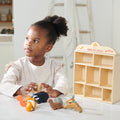How small world play builds spatial reasoning

Here is a child.
She kneels beside a wooden house. A tree goes here, a pond there. The animals must stay near the fence. She pauses, shifts one piece, and nods — it feels right now. Before any story begins, she is arranging her world.
This is small world play — the art of building miniature landscapes where imagination and logic quietly meet. Beneath the storytelling lies another kind of thinking: spatial reasoning — the ability to understand how things fit, move, and relate in space. Every time a child positions a tree or turns a figure to face the right way, she’s training her mind to visualise, rotate, and organise the world.

From narrative to navigation
We often think of small world play as storytelling — a social or linguistic activity. But before there’s plot, there’s placement. Children spend long stretches arranging, aligning, enclosing, and connecting objects before acting out any story. These patterns are far from random; they show an emerging understanding of proximity, orientation, and containment.
In this way, small world play bridges two essential forms of early learning: constructive play and dramatic play. It’s both architectural and imaginative — a kind of rehearsal for how space and story intertwine.
The world as a map
When your child lays out a miniature landscape, she’s building a map of her own making. Houses on hills, rivers between forests, fences around farms — these layouts express what researchers call schemas such as enclosing, positioning, connecting, and transporting. Through them, children begin to grasp distance, direction, and symmetry.
That same mapping ability underpins later skills in mathematics, design, and even literacy. Understanding that “the barn is behind the field” or “the car crosses the bridge” lays the groundwork for interpreting diagrams, reading maps, and writing sequences — all forms of spatial logic.
You can see this most clearly in dolls houses and miniature settings. These toys invite children to create order, recognise relationships, and make sense of spatial boundaries — a quiet foundation for later reasoning.
The logic of placement
Watch a child at play and you’ll see an internal geometry at work. There’s the instinct to balance — trees evenly spaced on either side of a road. There’s the use of boundaries and centers — a house as focal point, a fence enclosing territory. And there’s the fascination with routes — roads, bridges, and tracks that connect one place to another.
Each decision reflects a form of visual reasoning. The child predicts what will fit, what connects, and what feels right in relation to everything else. It’s early problem-solving — long before formal geometry lessons begin.
Play sets like building blocks and open-ended loose parts help develop this sense of structure. When children later bring those same pieces into their small worlds, they’re transferring spatial skills from one play context to another — a powerful developmental leap.

Hands-on geometry
Though miniature, this play is deeply physical. Children lean in, rotate figures, and stretch to connect distant points on the mat. These small gestures build neural pathways for mental rotation and spatial visualisation — the same abilities used in science, art, and engineering later on.
In a world where screens often flatten experience, small world play reintroduces depth and dimension. The hand learns first; the mind follows. A child who moves a tree to “make room for the bridge” is practicing the same mental flexibility an architect or designer will one day use.
Many parents notice this when children spend longer arranging a scene than playing through it. That arrangement isn’t wasted time — it’s thinking made visible.
From construction to representation
Some children are drawn to the structure more than the story. They may never move their figures at all, instead creating carefully composed landscapes that resemble pictures. This visual mode shows an early sense of composition, balance, and perspective. Others move fluidly from arranging to acting, using spatial sense to support narrative coherence. Both modes reflect representational thought — the understanding that one thing can stand for another.
Play environments like wooden animals, furniture sets, and miniature houses give children materials that can shift between construction and storytelling, structure and symbol — wherever their thinking leads.
How to support spatial thinking through play
- Offer movable, varied objects. Include fences, bridges, trees, vehicles, and animals. Each invites different spatial relationships.
- Provide horizontal space. A mat, tray, or table lets relationships become visible and persistent.
- Notice before you narrate. Instead of asking “Who’s in the house?”, try “You’ve put the forest around the pond — what made you choose that?”
- Capture arrangements. Photograph her setup before the story begins. Seeing her own order reinforces awareness of structure and pattern.
As you observe, you’ll start to see how schemas like enclosing, connecting, and positioning appear naturally. These are the brain’s blueprints for understanding space.
Every small world is a kind of diagram
When a child builds a miniature world, she’s not just creating a story — she’s constructing a system. She’s discovering how objects define boundaries, how distance changes meaning, and how patterns emerge through placement. The figures and furniture are tools for thinking in three dimensions.
Every symbolic play scenario is also a spatial reasoning exercise. The story gives meaning, but the arrangement gives form to thought.
So next time you see a tiny world taking shape across your living room floor, look closely. You’re watching your child think in space — one small placement at a time.






